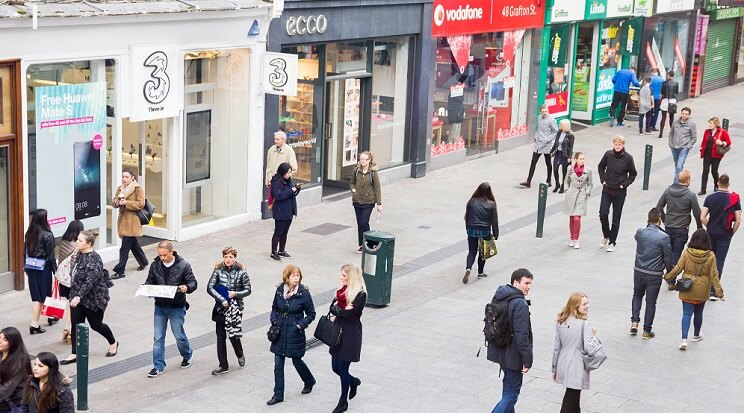
On 4th November 2020, the Women in Residential Property network met for yet another engaging industry discussion; this time, about the future of the high street. Hosted by WiRP Chair Emma Vigus (also MD of mio), guest speakers Damian Sumner, Partner at Brasier Freeth, and Trevor Watson, Director at Davis Coffer Lyons, shared their first-hand experiences of how the high street is adapting to the challenges of a changing market.
The session was run in support of Ella’s, a charity which supports women who have been the victims of trafficking and sexual slavery.
The changes we’re seeing haven’t sprung up overnight
The high street continues to face massive challenges in dealing with an increasing amount of surplus space owing to businesses closing their doors due to administration; move online or to out-of-town retail parks. Shoppers are increasingly drawn to the convenience of online shopping particularly in the face of rising car parking charges and localised congestion. The recent pandemic has only exacerbated these issues, as Damian Sumner comments: “It’s important to remember that the changes we’re seeing haven’t sprung up overnight because of coronavirus. We’ve been seeing change on the high street for a long time, it’s just that the current situation has dramatically accelerated this.”
The concept of the high street is tightly woven into the social fabric of our society
“Don’t throw the baby out with the bath water” is an adage pertinent to the future of the high street. The concept of the high street can’t simply be discarded, as it is tightly woven into the social fabric of our society – from the commercial property investments held in our pension funds, to playing an important role in our sense of community and well-being.
There is also a surprising link between physical space and online shopping, which continues to make high street store fronts a valuable asset for retailers – albeit not all of them. Beyond the more obvious click and collect services, brand awareness and PR, research has shown that if retailers don’t have physical space in a particular region, their online business suffers in those areas.
Mixed use spaces to live, work, and play will become increasingly important
Our high streets will continue to exist, just not as we know them, as Trevor Watson comments “The death of the high street is exaggerated. Mankind has had city centres for generations, and they will continue to be places for people to meet. However, we will see a shift away from tangible retail usage to other activities such as hospitality, members clubs, coffee shops and experiential leisure.”
Mixed use spaces to live, work, and play will become increasingly important to the survival of the high street – but collaboration will be fundamental to how well these spaces serve their communities. Unfortunately, there have been cases where attempts at creating mixed use spaces have favoured housing needs over those of commercial occupiers, and this has resulted in spaces which aren’t viable for retail and hospitality businesses. To truly succeed, there needs to be an element of localised collaboration that brings various professionals together – including developers and surveyors – to ensure the emerging spaces are truly mixed use and work effectively for everyone.
Some towns and cities are proactively adapting to the changing demands of the community. For example, residents in Basildon and Southampton will see a steady reduction in the amount of retail space, in favour of creating more housing. This is the approach more towns and cities need to adopt, to ensure their high streets change with the times – and don’t disappear.
We’re seeing a shake-up in how space is made available to retailers
It’s not just about the use of the space either, it comes down to how units are priced, the length of leases available, and how units are fitted out and how adaptable the spaces are. Many landlords have had to rethink how they offer their space to their potential clients in order to remain competitive, as Trevor Watson comments, “Opportunities for pop ups now are huge, and I believe that pop-ups with rents based on turnover will be with us longer term. We’re also seeing more demand for fitted or partially fitted units, which are quick and easy to move into and repurpose, as the renting model shifts towards a more flexible approach. However, that doesn’t mean that fixed rents will disappear, as they are tightly linked to the investment community, and operators would prefer to pay a fixed rent if they are confident in their revenue stream and have a strong product and a good brand.”
There continues to be winners and losers in the ever-changing face of the high street
Conditions remain tough on the high street. There is no telling when social distancing measures will be revoked, or if the country will face a third lockdown. Beyond this, many retailers are also bracing themselves for the impact of Brexit and the removal of the rent moratorium, where no doubt some landlords will be calling in back payments and forcing many businesses to make tough decisions to ensure their survival.
However, as with all change, there’s opportunities too. Even in the midst of the pandemic, there are still “winners”. Damian Sumner highlighted several retailers who have performed strongly throughout the last 6 months. These included retailers in the DIY and home interiors sector who’ve benefited from high demand as homeowners used lock-down to improve their homes and casual wear brands who’ve cashed in on the declining demand for formal wear. Damian also highlighted those retails who have a diversified presence across the high street, out of town retail parks and garage forecourts, Costa Coffee being a great example.
We’re also seeing a shift towards localisation and more affordable rents, as Damian Sumner comments: “We will see a re-basing of rents because of the collateral damage brought about by the pandemic and this will enable a new era of affordability which will create a great opportunity for businesses, who were previously priced out, to return to the high street”.
Trevor Watson highlighted regional variations in high street performance, “Retailers who’ve been heavily reliant on commuter trading are going to see a very slow recovery, and perhaps never return to ‘normal’ based on the growing likelihood that people will commute just 3 days a week – instead of 5 – as things eventually normalise. By contrast, leisure travel will bounce back very quickly, and places such as the West End will recover far quicker. Equally, we’re seeing trends in the London ‘villages’, such as Clapham, being mobbed with consumers taking advantage of local hospitality offerings. In these areas in particular, high street rental rates are standing their ground and we’re seeing very little reduction in cost.”
The future is uncertain, but not as bleak as mainstream media outlets would have you believe, and once the dust settles, there will very likely be a yearning of people wanting to get back onto the high street – whatever shape that may take.

TERRAFIRMA PRICE CHANGES – COMING 1ST JANUARY 2021
Terrafirma are making price changes to their CON29M, Ground Report and Coal Extra report – effective from 1st January 2021.

